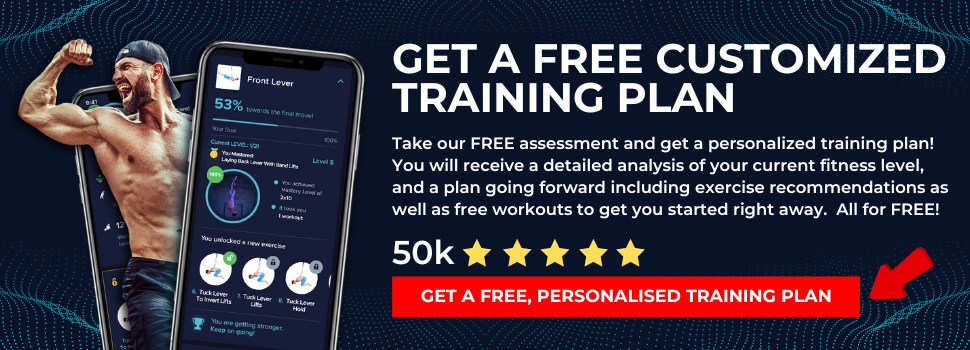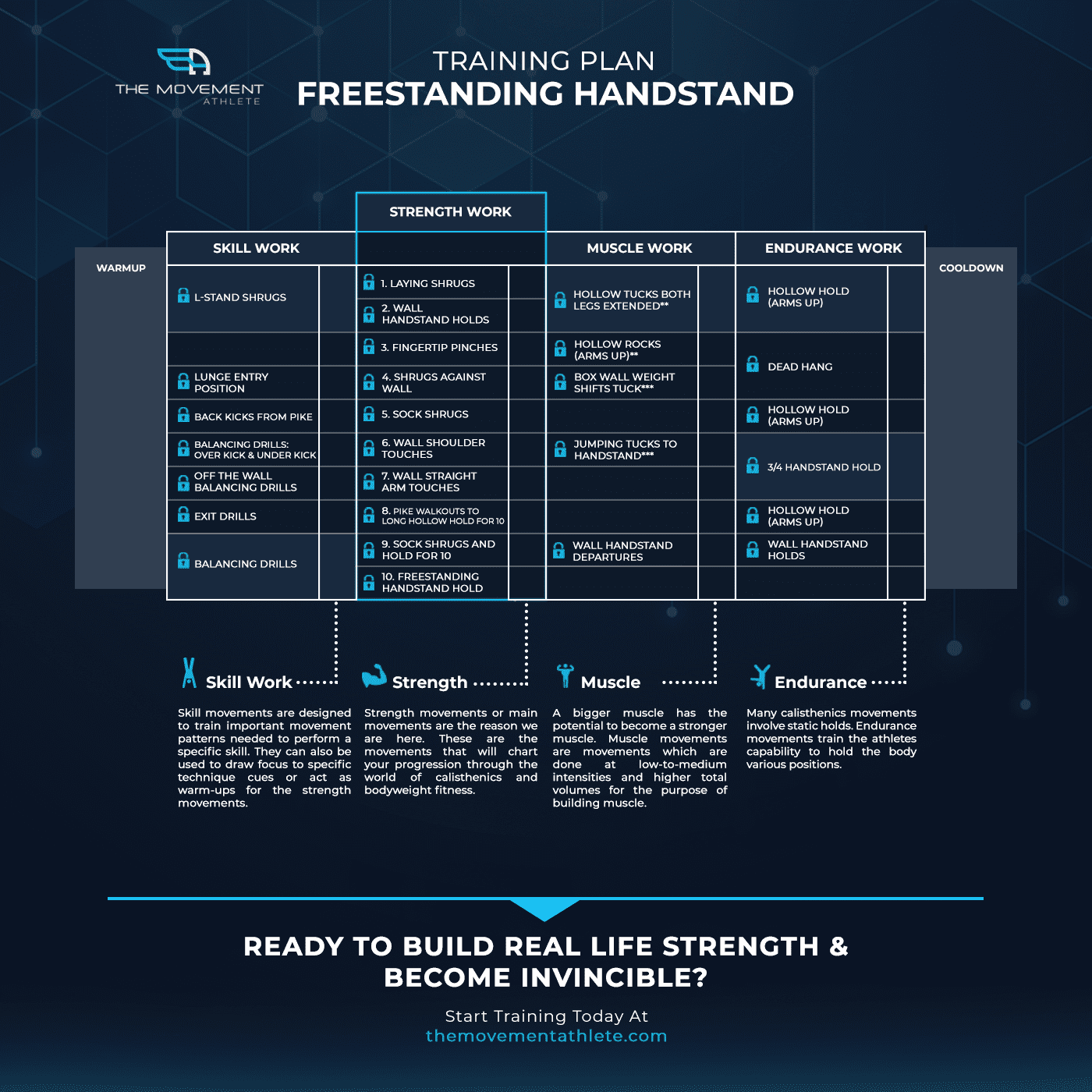Welcome to the Beginner Calisthenics Workout
Hey there, friend! So, you’re on the lookout for a beginner calisthenics workout, huh? Well, you’re in for a treat because I’ve got some valuable insights to share with you.
Let’s talk about a common mistake many people make when it comes to choosing a workout routine. They stumble upon a random PDF or online program and dive right in, without stopping to consider if it’s actually the right fit for them. Sound familiar? Trust me, after training thousands of athletes, my team and I have seen this scenario play out time and time again.
Imagine this: someone jumps straight into pull-ups when they’re not quite ready, or others find themselves stuck in a rut because their workouts are just too light. Frustrating, right?
Now, if you follow a random training program, you’re likely to encounter two main issues: first, “What if I can’t do some of these exercises?” You might power through and end up with an injury. And second, you might not make any progress because the training plan is just too easy for you. It’s a real dilemma that many folks face.
So, here’s the thing: one-size-fits-all routines just don’t cut it. They might be convenient, but they often miss the mark when it comes to personalized progress. That’s why we, at The Movement Athlete Academy, have taken a different approach.
We used to categorize workouts based on standardized levels like beginner, intermediate, and advanced. But guess what? That approach held back our athletes’ progress. We’ve even delved deep into this topic in our blog post, “The End of Beginner/Intermediate/Advanced – How personalisation is the key to calisthencis training that will make you invincible”
The bottom line? Lack of personalization can seriously hinder your progress.
Imagine trying exercises that are too challenging – it’s a recipe for poor form, movement dysfunction, and potential injury. On the flip side, if the exercises are too easy, you’re not challenging your muscles enough to grow. It’s a lose-lose situation.
That’s why we’ve created The Movement Athlete Academy: to provide fully personalized training programs tailored to your individual level for optimal performance. And guess what? You can take our FREE assessment and get a customized training plan just for you.
But hey, if you need more information, below, we will show you excatly how we create workouts, what are the elements of a successful calisthenics routine especially for a beginner and give you an example workout that you can do at home.
But here’s the kicker – if you take our free assessment first, we’ll whip up a personalized training plan just for you, tailored to your unique strengths and goals. No need to risk injury or worry about which exercises are right for you. Trust me, it’s a game-changer. Let’s make some gains together!
How to create the most effective beginner Calisthenics workout plan
Alright, let’s dive into how we approach creating a workout tailored just for you. Well, let me break it down for you.
Calisthenics is undeniably powerful, but for it to truly work its magic, it needs to be structured, progressive, personalized, and adaptive. And that’s exactly what you’ll experience when you join The Movement Athlete Academy.
Here’s the lowdown on what happens when you sign up:
1. In-depth Assessments for beginner calisthenics workout:
We commence with comprehensive assessments to grasp your current abilities, strengths, and areas for improvement. We need to determine whether you need to work on fundamentals or if you’re ready to tackle advanced movements. For instance, if you haven’t mastered the pushup yet, we need to ascertain at which stage of the progression you currently stand. Perhaps you possess enough strength for a handstand, but your mobility is lacking. These are all crucial pieces of information we require before crafting an effective training program tailored to your needs.
2. Personalized Training Program:
Building upon your assessment results, we design a personalized training program exclusively for you. This involves pinpointing the skills you need to focus on and charting a path to achieve them. For example, if you’ve achieved mastery-level proficiency in pushups, it’s a clear indicator that you’re ready to progress to advanced pushing movements.
3. Daily beginner workouts:
You’ll receive daily workouts that adapt based on your feedback and progress. Think of it as leveling up in a game – as you advance, you unlock increasingly challenging skills.
Why do we do this? Because this isn’t just another 8-week program; it’s an invitation to embark on a journey of bodyweight mastery.
Elements of a proper calisthenics routine for beginners and advanced
Now, let’s talk about the real magic that happens during your workouts. Calisthenics is complex, my friend. It’s not just about brute strength; it’s about mastering a combination of elements:
When building a training program for any calisthenics skills we always use 4 categories:
- ✅ Strength
- ✅ Skill
- ✅ Muscle
- ✅ Endurance
Let’s look at each one of those separately.
-
👉Skill Work: Technique is key. We focus on mastering movement patterns and specific technique cues to lay a solid foundation.
-
👉Strength Work: These are the bread and butter of calisthenics. We chart your progression through a variety of strength movements, optimizing reps and sets for building strength.
-
👉Muscle Work: Building muscle mass is crucial for strength and performance. Our muscle movements are designed to target specific muscles and optimize volume for muscle growth.
-
👉Endurance Work: Holding positions is no joke. We train your ability to maintain various positions for extended periods, building endurance and resilience.
And here’s the kicker – while many programs overlook these elements, we’ve structured your training program around them to create a holistic approach for all-round development.
So, every daily workout in The Movement Athlete app incorporates these key elements: warmup and mobility, skill work, strength work, muscle building, endurance work, and cooldown with flexibility work.
It’s critical, yet surprisingly overlooked by many.
And this is how this looks inside our app
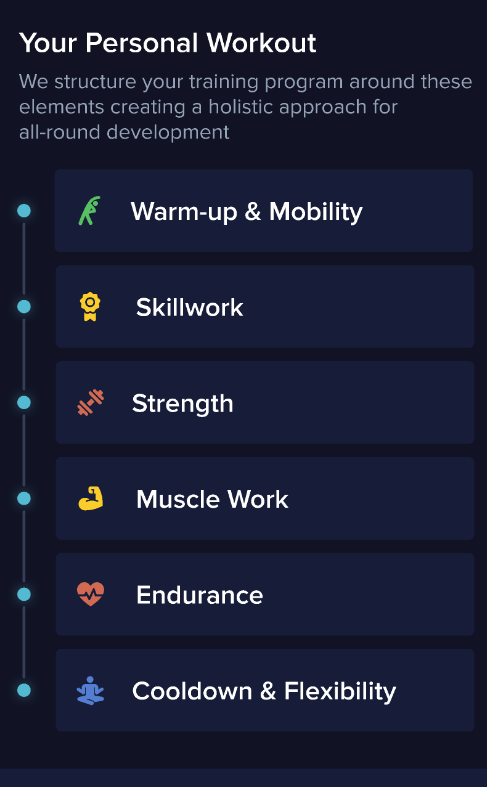
What exercises you should be working on in your as a beginner?
You already know that the answer is – it depends on where you are at.
But there i still a structure to how you pick what you should be working on. We call it fundamentals and they are the basis for all advanced calisthenics moves. That means that under fundamentals we need to cover your full body strength & mobility to prepare you for the next level.
So we have FUNDAMENTALS that cover:
- Pushing Mastery – vertical & horizontal
- Pulling Mastery – vertical & horizontal
- Leg Work,
- Core Work that includes Abs, Side and Back work and
- Bodyline work.
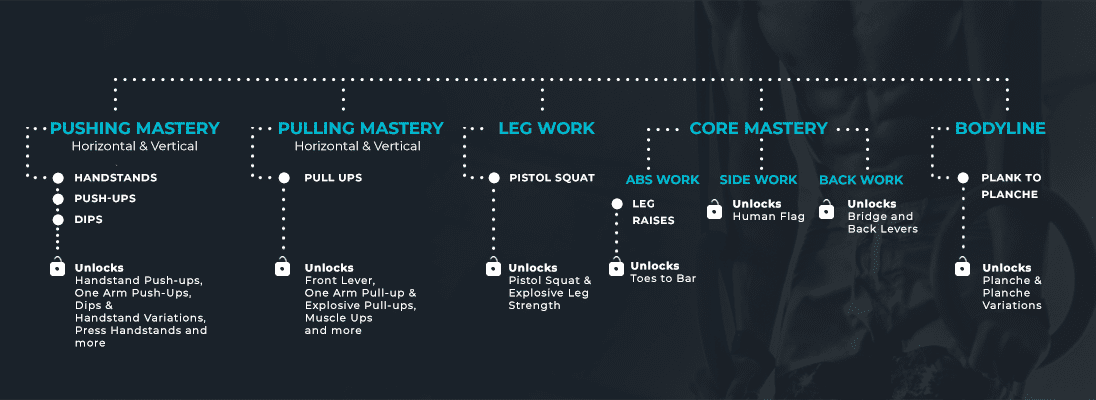
Each one of those constant of a progression that includes a number of the exercise that gets harder and harder. But before that let me explain what is a progression.
Progressions serve as a roadmap, guiding you step by step toward mastering a skill or enhancing your physical fitness attributes.
Take the handstand, for example. As you embark on your handstand journey, you’ll begin with the most basic progression. With each step forward, the next progression becomes increasingly challenging and multifaceted, akin to navigating through levels in a video game.
Each progression unlocks new challenges, pushing you to develop your skills further. And even as you tackle more advanced handstand progressions, the journey of progression continues, leading you toward mastering this complex motor skill.
So for example to achieve a push up here is how that would look like
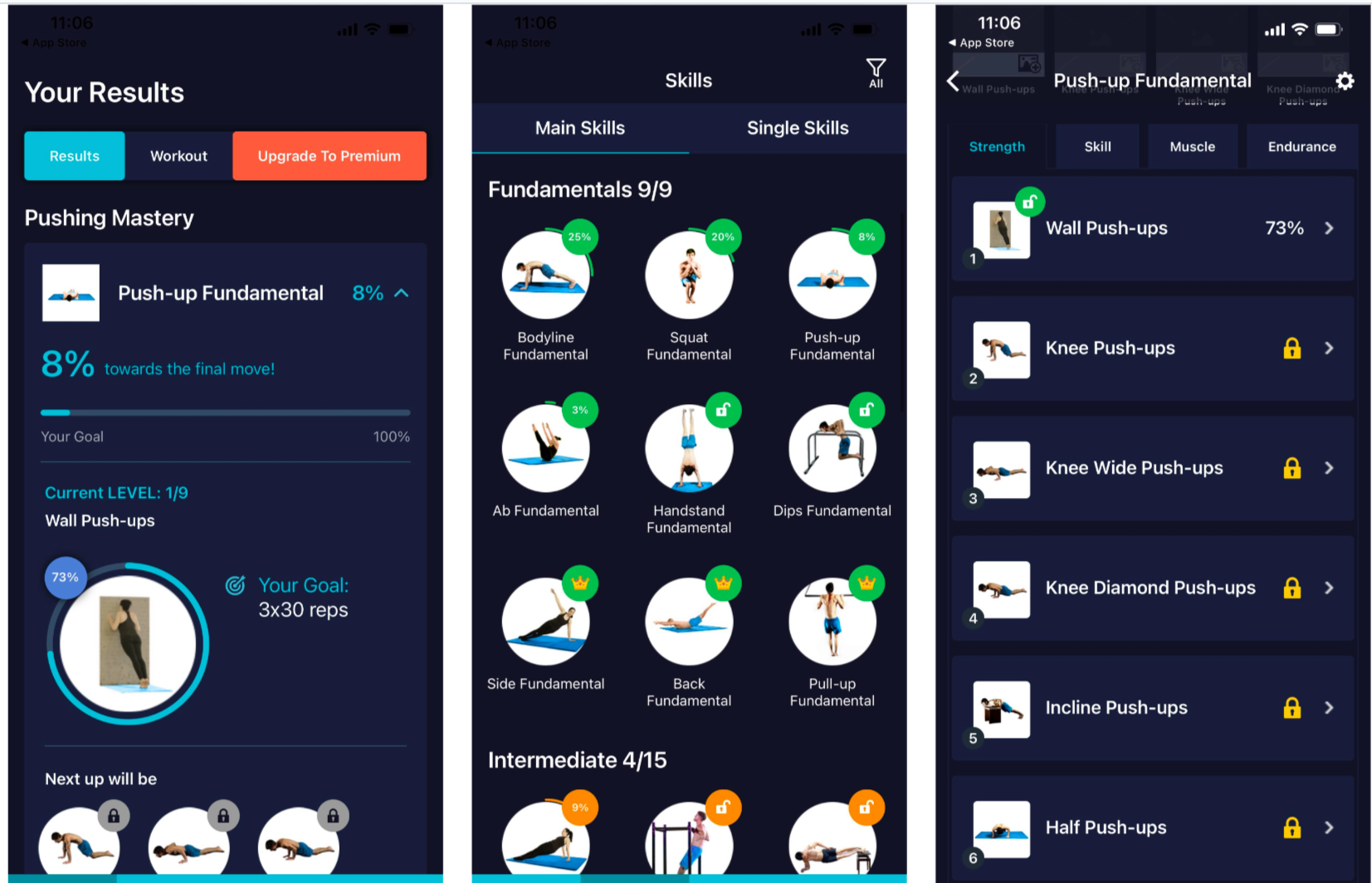
So where you should start on the progression?
NO, YOU SHOULD NOT START AT STEP 1.
HARDLY EVER anyone starts at STEP 1.
As you remember from our talks on AUTOREGULATION – for your training to be effective it needs to be both challenging enough so your muscles are getting challenged and will grow but also NOT too hard so you won’t get injured.
This is where the whole concept of beginner, intermediate, advanced can really hurt your training and get you injured.
It’s’ just not personalised enough.
SO WHERE SHOULD YOU START?
In the Movement Athlete Academy, we take it very seriously and through COMPREHENSIVE ASSESSMENT we get to understand where are you at this JOURNEY (meaning where are you at on each of those progressions eg towards a pushup, dip, pull up, handstand or maybe you are done with all of the fundamentals and you are ready to tackle advanced skills.
We need to know!
And when we do – our system creates a TRULY PERSONALIZED TRAINING PROGRAM
So it could be that this is how your training will look like if you still need to work on fundamental
Pushup – Step 5 – Reps x
Handstand – Step 6 – Reps x
Dips – Step – 10
Pull-Up – Mastered – Unlocked One-Arm Pull-Up
Etc
Do you see how granular it gets? – AND IT SHOULD – because if we would give you a generic training program we risk that either you are wasting your time or you might get injured.
When you workout you advance on the progressions you are currently working on, pushing you one step closer to your goal.
This is a great way for you to track, visualise your progress and make sure that whatever you are doing is the most optimal path to get you there.
In the bigger picture here how the journey towards a Freestanding Handstand would look like:
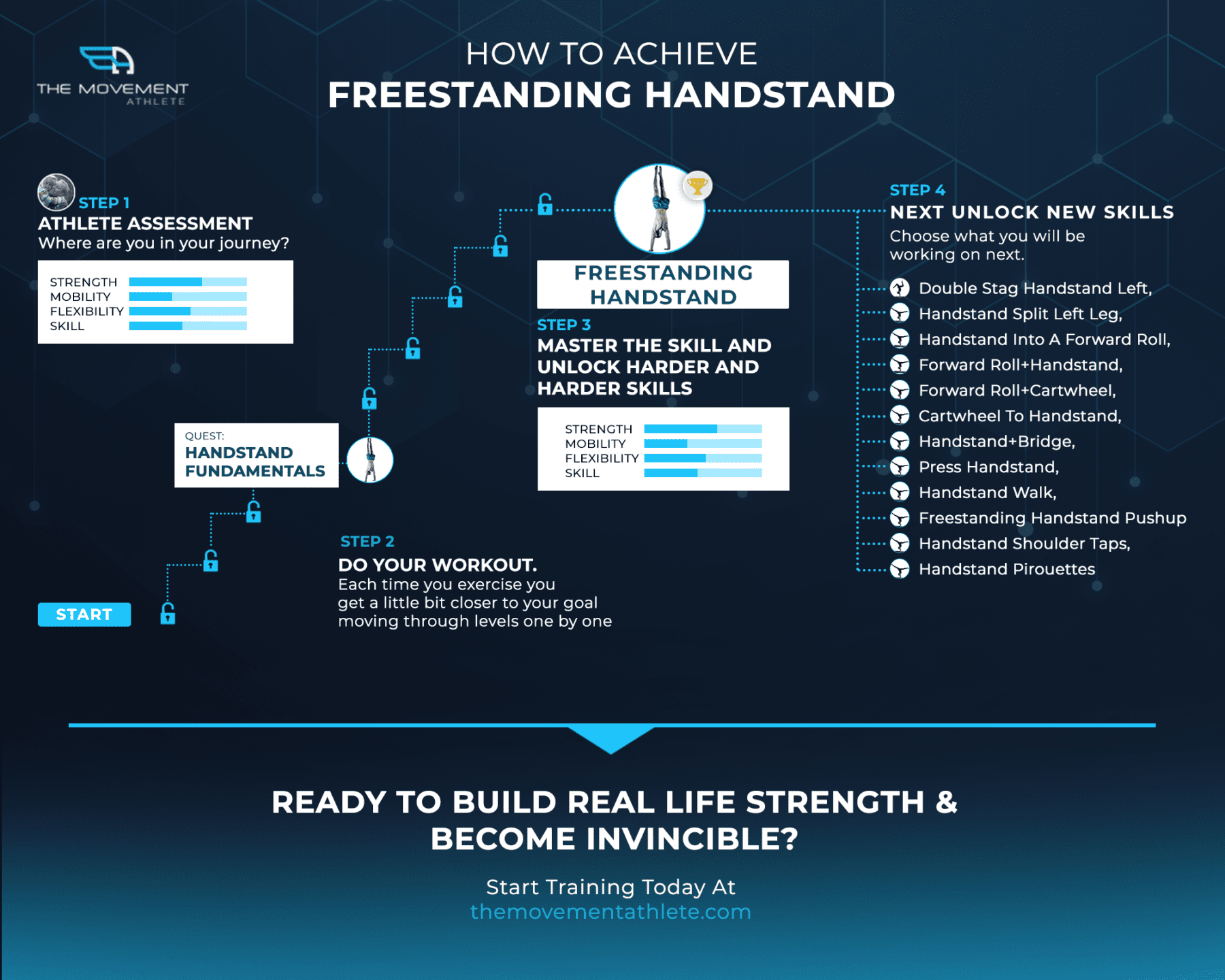
And this is how your whole journey and training plan would look like inside the app
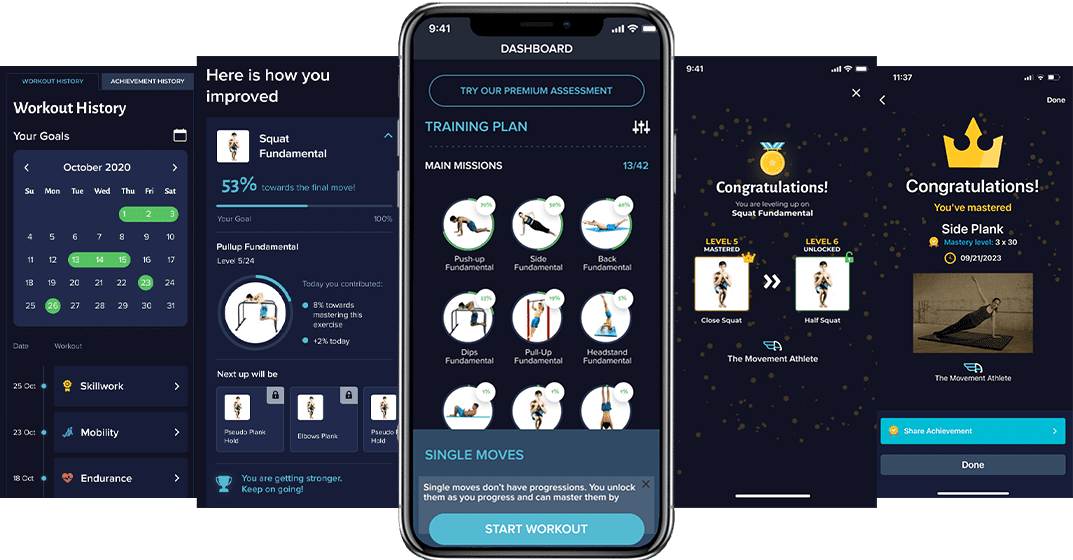
What a personalised calisthenics workout for beginners can do for you?
So, why bother with a personalized training plan when you can simply grab a PDF from someone else, right? The answer boils down to one word: injuries.
Let me tell you, as a fitness coach, I’ve witnessed countless individuals come to us after experiencing setbacks from following generic workout plans. These plans often fail to consider individual strengths, weaknesses, and limitations, leading to improper form, overexertion, and, ultimately, injuries.
Imagine attempting complex movements without proper guidance or progressing too quickly without building a solid foundation. It’s a recipe for disaster.
That’s where personalized training plans come in. By tailoring workouts to your specific needs and abilities, we minimize the risk of injuries and maximize your progress. Whether you’re a beginner or an experienced athlete, having a plan that aligns with your goals and capabilities is crucial for long-term success.
So, while it may be tempting to opt for a one-size-fits-all approach, investing in a personalized training plan is ultimately the safer and more effective choice. After all, your health and well-being should always come first.
But beyond avoiding the risk of a debilitating injury, progressive calisthenics, when executed properly, offers an incredible array of benefits. In our view, it stands as the pinnacle of bodyweight strength training, capable of aiding in weight loss, conditioning the nervous system, enhancing mobility, and fostering longevity in a way that other forms of training, such as weightlifting, may not achieve in the long term.
The transformative power of progressive calisthenics is undeniable. Countless case studies attest to individuals who have transitioned from weightlifting to calisthenics and never looked back. So, let’s delve into why this form of training is so potent and how it can revolutionize your fitness journey.
Insane strength
Contrary to popular belief, calisthenics can build strength like no other. Even though calisthenics workouts may not look as intense and intimidating as weight training, calisthenics is still able to build a solid level of relative strength in a very natural manner by using your own body weight against you — meaning that the resistance will always be present (unlike with weight training).
Calisthenics can’t compete with the level of absolute strength weight exercises can provide. But you’d be surprised by the weight gymnasts can lift! Here’s a video of gymnast Nile Wilson showing incredible strength even without training with free weights.
Targets all muscle groups
First of all, calisthenics can target any part of your body in an organic way, meaning that you can build muscle without the use of complicated machinery or artificial motions that push you to do one specific thing, yet leave the rest of your body completely untouched.
Holistic approach
Strength and muscle are just other elements in the calisthenics journey. It’s not everything. You also get to work on your balance, endurance, body control, mobility, and flexibility.
Teaches good habits
A beginner workout is a great way to develop good habits that will stay with you for the rest of your life.
In other words, if you want to develop muscle strength and/or build muscle mass, then calisthenics may be perfect for you as a beginner workout because it is an all-around exercise that can help build muscle in various ways. The movements are natural, effective, and functional.
Saves time
That’s what plans are for. It helps you get prepared, and you can save time for yourself to do other things.
Maintains consistency
Calisthenics training plan guides you to stick to a workout schedule, so you can stay consistent and not waste your time. It also directs you into a path of continual improvement.
Keeps it fun
You are only limited by your imagination, which is both the best way of keeping it interesting but also a great motivator because there are so many different exercises that will work all muscle groups in different ways.
0 to minimal equipment with the primary use of own body weight
You can work out without the need for any fancy equipment. For more optimal gains, it’s best to have at least these pieces of equipment:
- Pull-up bar
- Dip station
- Resistance band
- Stable elevated surface
- Low bar or gymnastics ring
All of these mentioned are affordable and accessible. You can also prepare a sturdy chair and wall to widen the number of calisthenics exercises to choose from.
If you need a detailed guide on calisthenics equipment, check out the article below:
Ultimate guide to calisthenics equipment and accessible alternatives
Functional movement
Functional movement is the art of doing things that are actually necessary for real life. In calisthenics, there’s a large focus on functional movements: all these exercises prepare you for handling tasks like climbing stairs, carrying groceries, and picking up heavy objects with ease.
There is also a great emphasis on core strength as it will make your everyday life a whole lot easier by making your body free of restrictions of movement and free from nasty body pains.
You can read more about it in the article below:
What does it mean to be strong in the real world?
Naturally progressive
Bodyweight exercises are naturally progressive in that the body is forced to adapt and get stronger over time.
Especially if you’re working with a proper calisthenics routine, your body and body weight will adjust accordingly to the demands; making you much lighter and more prepared for more advanced calisthenics exercises.
If you can’t believe it, here are stories of real people making real gains with calisthenics:
The best calisthenics beginners workout routine
It doesn’t have to be complicated!
It’s time we make fitness simple again.
Focus on calisthenics for the rest of your life, and you will never have to worry about getting strong again! We all know how hard it is to find time in our lives with everything going on that we want to do- so a workout plan helps us get back into shape while also giving us more freedom of movement, from aches and pain.
About this bodyweight training plan
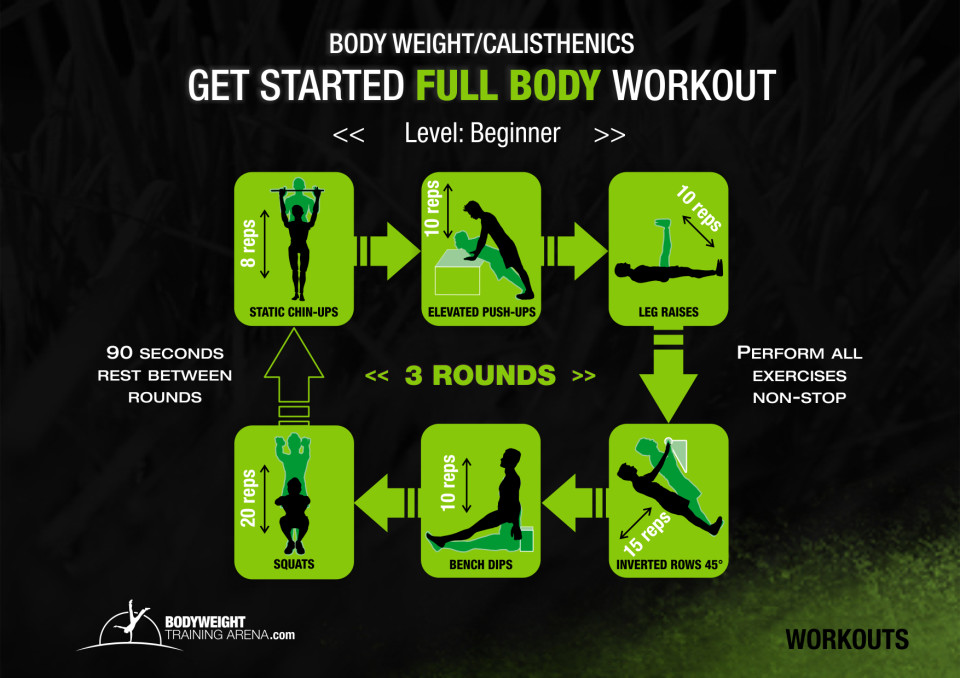
BASIC CALISTHENICS WORKOUT FOR BEGINNERS
Level:
Time
Goal
Beginner
25 minutes
Strength Building
Here is Your Workout :
| Move | Sets | Reps |
| Static Chin-ups | 1 | 8s |
| Elevated Push-ups | 1 | 10 |
| Leg Raises | 1 | 10 |
| Inverted Rows 45 Degrees | 1 | 15 |
| Bench Dips | 1 | 10 |
| Squats | 1 | 20 |
No rest between each exercise and rest for 90 seconds for each round. Total of 3 rounds.
How far in the game are you?
Our certified coaches have developed a fail-proof assessment to give you an idea of where you stand in the Calisthenics game.
Circuit training
Circuit training is a type of physical exercise that combines strength conditioning and aerobic exercise. It consists of a series of different calisthenics exercises, performed sequentially one after the other with little or no rest in between.
This workout plan is designed for a complete beginner in calisthenics looking to building muscle and losing fat in the process without the need for a gym membership.
Full body workout
We will use our entire body for this calisthenics workout plan, hitting the upper body and lower body, including our core. A whole-body workout will further increase the intensity of the session that amp’s up the potential gains.
That being said, you can work out using the program 3 times per week leaving at least 24 hours between sessions for maximum recovery.
FUNDAMENTAL strength training is THE MOST important goal for every beginner.
When first starting with calisthenics workouts or weight training or any other form of resistance training, the number one priority is strength training.
Why?
Because it’s the best time to maximize the “noob gains“.
What are noob gains you may ask?
It’s when our bodies experience neural adaptation. A phenomenon when our bodies’ muscle and strength gains decrease as we get more advanced in training. Beginners tend to make massive strength gains which is very useful if you want to progress to more difficult exercises to further increase your progress.
Strength training is exactly what beginners need to be focused on to set a proper foundation for further developments.
Apply these rules when performing any bodyweight exercises.
Know these key points by heart as you will be using these in all calisthenics exercises.
- Proper form for every exercise
- Core tight when executing movements
- Quality reps over quantity
- Whole-body tension
- Breath in during negative and breath out during the positive motion
- Use entire range of motion
- Mind-muscle connection – focusing on targeted muscles to increase muscle activation
Warm-ups
Start training with a proper warm-up. Dynamic movements do the trick! Avoid static stretches. Here’s a short and general guideline:
- Jumping jacks or any cardiovascular movements
- Joint rotations
- Arm swings
- Torso rotations
List of the best exercises for a calisthenics workout for beginners
Static Chin-ups (10 – 30 second hold)
Targets: Lats, back, biceps, core
Equipment: Pull-up bar or any sturdy beam
Let’s first start with one of the best isometric exercises to build upper body strength. This exercise is part of the pull-ups progression. It’s basically a chin-up (palm towards your body compared to a pull-up with palm facing away) but as an isometric hold at the top-most position. Why the top position? Because it’s the easiest position to hold in the motion apart from the dead hang, of course.

How to perform:
- Stand near a low bar.
- Jump to the top position of the chin-up.
- Hold the position for a specified amount of time.
Coaching Pointers:
- Push your shoulder down and away from your ears
- Pinch your shoulder blade together at the top position
- Head in a neutral position
- Hands shoulder-width apart or slightly wider/narrower depending on comfort
- Full-body tension
- Use leg assistance or band assistance to make the exercise easier
If you cannot do a chinup take our assessment to see a better exercise
Elevated Push-Ups (8 to 15 reps)
Targets: Chest, triceps, shoulders
Equipment: Rigid wall
One of the most popular calisthenics exercises known to man is push-ups. The push-up is great for building chest and tricep muscles but also good for shoulder strength and stability. The problem is that not all beginners can do a single rep with good form. To address this issue, it’s best to move to an easier exercise such as wall push-ups. The inclined variation lessens the load while still trains the necessary muscles for harder variations.

How to perform:
- Face the wall 1 to 2 feet away. Far enough so when you lay your hands on the wall, you can still lean towards it with straight arms.
- Stand with good posture. Feet together.
- Place your hands flat shoulder-width apart on the wall.
- Pull your body towards the wall by bending your elbows.
- Stop until your chest is near the wall.
- Push up using your chest and tricep muscles back to starting position.
- Repeat the motion for reps.
Coaching Pointers:
- Push your shoulder down and away from your ears
- Pinch your shoulder blade together at the bottom position
- Head in a neutral position
- When bending your elbows, keep them tucked near your body
- Keep your body straight throughout the motion
Leg raises
Targets: Abs
Leg raises are excellent for the core muscles particularly the abs which is crucial for calisthenic exercises. The key here is to perform with correct form since many make minor errors that affect the overall effect of the exercise.

How to perform:
- Begin lying on the floor. Hands by your side.
- Lift the legs up until the hips are past 90 degrees.
- Lower down with control but do not let the feet touch the ground.
- Repeat for reps.
Coaching Pointers:
- Keep the back fully flat on the floor. You can do this by tilting the hips a bit forward.
- Use the abs to move the legs
- Do not rely on momentum
- Legs engaged
Inverted 45-degree row
Targets: Lats, back, biceps, core
Equipment: Low bar, dip bar, or gymnastics rings
Bodyweight rows are integral to developing strong pulling mechanics. It can also lead to pull-ups while you don’t have the strength yet for the exercise. Luckily, rows are scalable for beginners.

How to perform:
- Hang from a low bar.
- Extend the legs forward and straighten the body and arms.
- From the bottom position, pull upward until the chest is near the top position.
- Lower down with control.
- Repeat the pulling motion for reps.
Coaching Pointers:
- Push your shoulder down and away from your ears
- Pinch your shoulder blade together at the top position
- Head in a neutral position
- When bending your elbows, keep them tucked near your body
- Adjust the angle to adjust the intensity of the exercise. The lower, the harder. The higher, the easier.
Bench dips (10 to 25 reps)
Targets: Chest, triceps, shoulders
Equipment: Bench or box
This is an introductory exercise to vertical pushing motion. It works primarily the triceps, chest, and shoulders. Like other calisthenics exercises, it cal also be adjusted to suit your skill level.
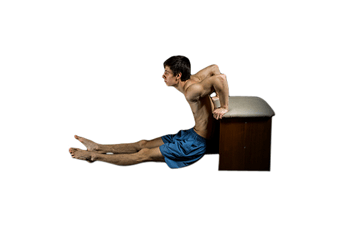
How to perform:
- Sit down on a bench and place your hands near your thighs.
- Extend your hips forward and walk your feet further until straight.
- Lower down your body by bending at the elbows.
- Push back up to starting position.
- Repeat for reps.
Coaching Pointers:
- Push your shoulder down and away from your ears
- Pinch your shoulder blade together
- When bending your elbows, keep them tucked near your body
- Lower down to the maximum range of motion but aim to reach 90 degrees in arms or deeper
Bodyweight squats (10 to 25 reps)
Targets: Glutes, hamstrings, quads, calves
Equipment: Optional – box or wall for support
The squat is a great exercise with many variations for different goals and skill levels. For our purpose, you can either use a box behind you for assistance or go full bodyweight instead. You can also make the exercise more difficult by implementing jumping squats or unilateral variations.

How to perform:
- Begin standing with good posture in legs shoulder-width apart. Feet facing forward or slightly outwards.
- Squat down by bending at the hips and knees.
- Lower to the maximum range of mobility.
- Hold the bottom position for a brief moment.
- Stand back up by pushing with your legs.
- Repeat for reps.
Coaching Pointers:
- When lowering down, the upper torso will be diagonal.
- Raise hands in front for balance
- Hips squared
- Maintain stabilized knees
- Slowly go deeper as your mobility improves
Where does mobility come in?
These strength exercises above aren’t just for building muscle and gaining power. If they are done with perfect form, bodyweight movements also develop strength in a wider range of motion which equates to mobility.
Mobility can be improved through static stretching, but it’s best trained with strength exercises.
To Wrap it up
Start with a good solid foundational routine
Creating a solid foundation like the base for an architecture and engineering marvel is essential to getting stronger. Just like having a solid foundation of trust and love is important for a strong and lasting relationship.
If you are just getting started you want to make sure your workouts consist of all fundamental movemenys – pushing, pulling, legs and core.
We can go on and on with metaphors here. An excellent and proper routine will set the foundation for your fitness and calisthenics journey.
But what if these exercises are too hard for you or too easy?
But what if these exercises are too hard or too easy for you? The ultimate full body calisthenics workout for beginners is personalised
You already know that the best calisthenics fitness program for beginners to advanced athletes is highly individualized and will vary from person to person depending on your current level of strength, age, weight, fitness goals, etc.
If you truly want to experience the ultimate calisthenics workout plans, you need something that’s specifically designed for you. You need personalization!
Cookie-cutter or one-size-fits-all programs are proven to be inefficient, hurting your gains, and can potentially be dangerous if the program is too difficult for you.
Like every person is different, every beginner is different as well.
The end of beginner/intermediate/advanced – that is hurting your training.
That’s why The Movement Athlete is such as beast compared to any other workouts out there!
It focuses on your journey and your progress alone.
Take the assessment now and see where you are at with your 9 calisthenics fundamentals.
Learn where to start so you’ll know where you will be heading.

